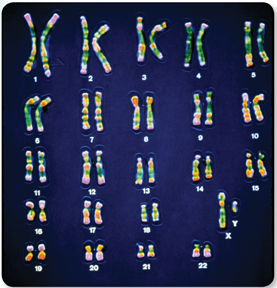14.1 Human Chromosomes
 What is a karyotype?
What is a karyotype? What patterns of inheritance do human traits follow?
What patterns of inheritance do human traits follow? How can pedigrees be used to analyze human inheritance?
How can pedigrees be used to analyze human inheritance?
genome • karyotype • sex chromosome • autosome • sex-linked gene • pedigree
Outline Before you read, make an outline of the major headings in the lesson. As you read, fill in main ideas and supporting details for each heading.
THINK ABOUT IT If you had to pick an ideal organism for the study of genetics, would you choose one that produced lots of offspring? How about one that was easy to grow in the lab? Would you select one with a short life span in order to do several crosses per month? How about all of the above? You certainly would not choose an organism that produced very few offspring, had a long life span, and could not be grown in a lab. Yet, when we study human genetics, this is exactly the sort of organism we deal with. Given all of these difficulties, it may seem a wonder that we know as much about human genetics as we do.
Karyotypes
 What is a karyotype?
What is a karyotype?
What makes us human? We might try to answer that question by looking under the microscope to see what is inside a human cell. Not surprisingly, human cells look much like the cells of other animals. To find what makes us uniquely human, we have to look deeper, into the genetic instructions that build each new individual. To begin this undertaking, we have to explore the human genome. A genome is the full set of genetic information that an organism carries in its DNA.
The study of any genome starts with chromosomes—those bundles of DNA and protein found in the nuclei of eukaryotic cells. To see human chromosomes clearly, cell biologists photograph cells in mitosis, when the chromosomes are fully condensed and easy to view. Scientists then cut out the chromosomes from the photographs and arrange them in a picture known as a karyotype (KAR ee uh typ).  A karyotype shows the complete diploid set of chromosomes grouped together in pairs, arranged in order of decreasing size.
A karyotype shows the complete diploid set of chromosomes grouped together in pairs, arranged in order of decreasing size.

FIGURE 14–1 A Human Karyotype A typical human cell has 23 pairs of chromosomes. These chromosomes have been cut out of a photograph and arranged to form a karyotype.

Table of Contents
- Formulas and Equations
- Applying Formulas and Equations
- Mean, Median, and Mode
- Estimation
- Using Measurements in Calculations
- Effects of Measurement Errors
- Accuracy
- Precision
- Comparing Accuracy and Precision
- Significant Figures
- Calculating With Significant Figures
- Scientific Notation
- Calculating With Scientific Notation
- Dimensional Analysis
- Applying Dimensional Analysis




